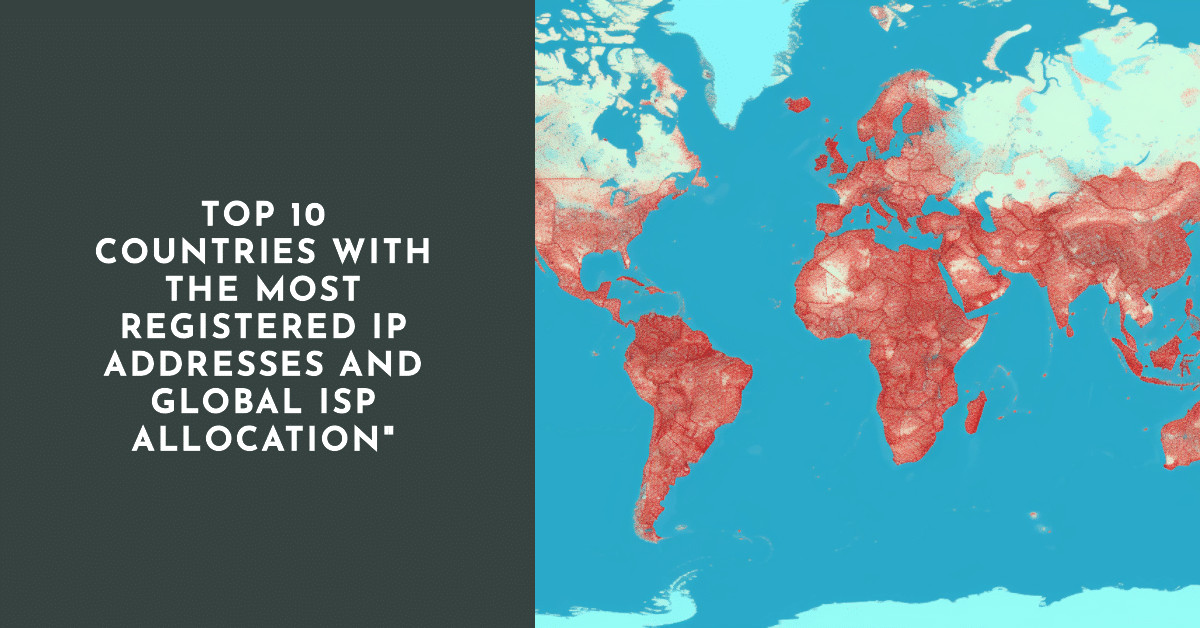
Internet Protocol (IP) addresses are unique numerical identifiers assigned to each device on a computer network. Serving two key functions, they identify the host or network interface and provide the host’s location within the network. In the context of global connectivity, the number of registered IP addresses in a country signals its level of internet usage, digital infrastructure, and technological advancement. As such, they are critical to understanding the global digital economy.
IP address allocation and registration are coordinated by five Regional Internet Registries (RIRs). These are:
- American Registry for Internet Numbers (ARIN)
- Réseaux IP Européens Network Coordination Centre (RIPE NCC)
- Asia-Pacific Network Information Centre (APNIC)
- Latin American and Caribbean Network Information Centre (LACNIC)
- African Network Information Center (AFRINIC)
These organizations manage IP address space distribution within their respective regions.
Unveiling the Top 10 Countries with the Most Registered IP Addresses
The data below presents the top 10 countries with the most registered IP addresses as of 2023:
| Country | Number of Registered IP Addresses |
|---|---|
| United States | 1,541,605,760 |
| China | 330,321,408 |
| Japan | 202,183,168 |
| Germany | 188,132,104 |
| United Kingdom | 123,500,144 |
| South Korea | 112,239,104 |
| France | 95,078,032 |
| Canada | 79,989,760 |
| Italy | 50,999,712 |
| Brazil | 48,572,160 |
Global ISP Allocation by Region
The following data provides insights into the global distribution and utilization of IPv6 addresses, the most recent version of Internet Protocol, as of September 2022:
| Region | Area Covered | IPv6 Addresses Allocated | Available | Reserved | Utilized |
|---|---|---|---|---|---|
| AFRINIC | Africa | 1,049,088 | 1,016,846 | 22,382 | 9,860 |
| APNIC | Southern Asia and Oceania | 1,066,993 | 838,810 | 129,485 | 98,698 |
| ARIN | North America | 2,099,712 | 1,393,318 | 636,344 | 70,050 |
| LACNIC | Central and South America | 1,048,934 | 994,465 | 38,471 | 15,998 |
| RIPE NCC | Europe and North/Central Asia, including the Middle East | 2,131,964 | 843,772 | 1,117,609 | 170,583 |
Making Sense of the Data
A closer look at the data reveals key trends and implications. The significant number of registered IP addresses in the United States, China, and Japan emphasizes their strong positions in the digital economy. On the other hand, the ISP allocation data shows a broader view of global connectivity, highlighting potential areas of digital expansion and growth.
FAQ
-
How does the number of registered IP addresses reflect a country’s digital standing?
The number of registered IP addresses indicates the extent of internet usage, technological advancement, and digital infrastructure. It also hints at the country’s digital economic strength.
-
Which organizations handle IP address allocation?
Five Regional Internet Registries (RIRs) are responsible for the allocation of IP address space in their respective regions.
-
How dynamic are these rankings and allocations?
These rankings and allocations can change due to several factors, such as digital infrastructure development, population changes, and shifts in technology usage.
-
What can a country do to acquire more IP addresses?
Countries can acquire more IP addresses by enhancing their digital infrastructure and increasing internet usage. The respective Regional Internet Registry also plays a role in IP address allocation.
-
Is every device assigned a unique IP address?
Each device connected to the internet is assigned a unique IP address for identification and location addressing.
-
What means IP Utilized?
“IP Utilized” refers to the number of IP addresses that are actively being used by devices or allocated to end users within a given network or region.
In the context of the provided data, this indicates how many IPv6 addresses are currently being used in each region. This can serve as a measure of how well a region is adopting IPv6, the most recent version of the Internet Protocol, as well as a broad indicator of internet activity within the region.
In other words, an IP address would be considered “utilized” when it is assigned to a device and that device is connected to the network. The extent to which a region’s allocated IP addresses are utilized can reflect various factors, including the size and activity of its online population, the development of its digital infrastructure, and its general level of technological advancement.






Comments (0)
There are no comments here yet, you can be the first!